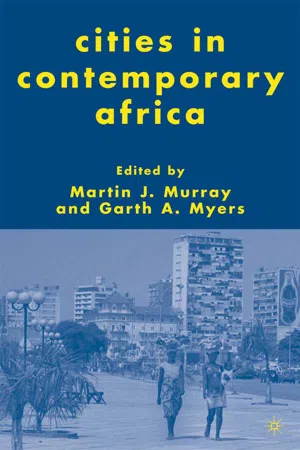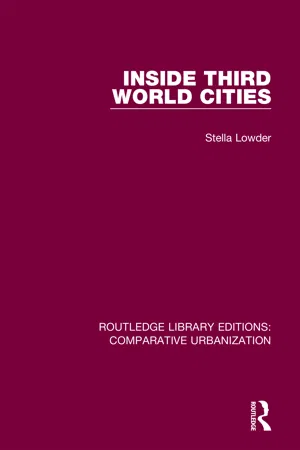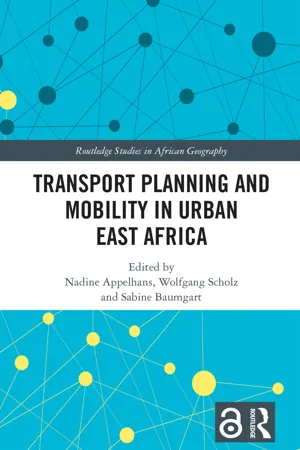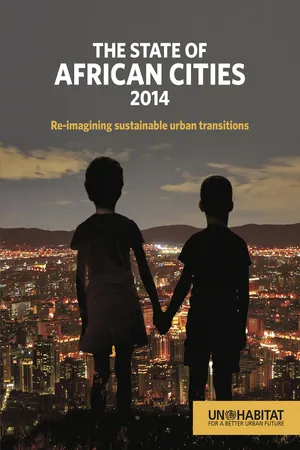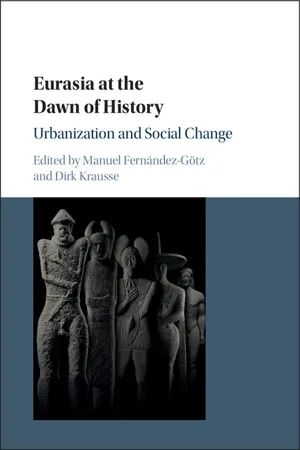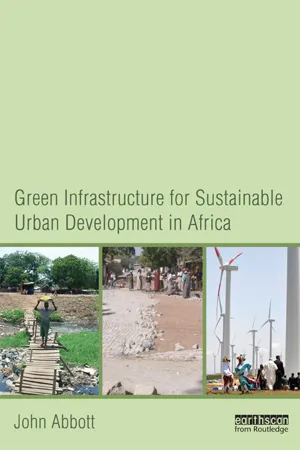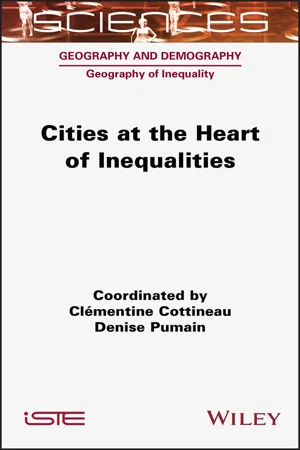Geography
African City Model
The African City Model is a conceptual framework used to understand the spatial organization and development of cities in Africa. It emphasizes the unique characteristics of African urban areas, such as informal economies, rapid urbanization, and diverse cultural influences. The model highlights the complex interplay between traditional and modern elements in shaping the urban landscape of African cities.
Written by Perlego with AI-assistance
Related key terms
1 of 5
11 Key excerpts on "African City Model"
- eBook - PDF
- M. Murray, G. Myers, M. Murray, G. Myers(Authors)
- 2007(Publication Date)
- Palgrave Macmillan(Publisher)
It is undoubtedly true that cities in Africa are, for the most part, distressed places in need of good governance, effective management, refurbished infrastructure, greater popular participation in local decision-making, sustainable livelihoods, and expanded opportunities for socioeconomic advancement. Yet they are more than simply manifestations of failed urbanism. Unless we move outside this diag- nostic mind-set with its normative injunctions, we will be unable to discover and appreciate the historical specificity of cities in Africa—how they make themselves at the same time they are made (Simone 2004: 15–16). As a general rule, the conventional urban studies literature conceives of cities as discrete entities—unitary objects of inquiry—that can be understood inde- pendently of location within global networks and outside their historical con- text. Yet cities in Africa are not just physical locations defined by their geographical boundaries, but platforms or “jumping-off” points for the realiza- tion of individual needs and collective aspirations. Cities evolve and function in relational networks, as nodal points facilitating circulation, movement, and tran- sit. Just as we can conceive of multiple modernities, we can imagine a variety of different pathways of urbanization and divergent modalities of urban life. Theoretically S pecifying Cities in Africa: I dentification and Classification What is striking about cities in Africa is their astonishing diversity and heterogeneity. Though many cities in Africa came into existence as overseas extensions of metropolitan colonial powers seeking to establish beachheads on the African continent, their subsequent growth and development did not con- form to a linear logic or uniform pattern. City-building processes that took place under the dominance of European colonialism often left an indelible imprint on the original spatial layout, the built environment, and architectural styles of cities and town in Africa. - eBook - ePub
- Stella Lowder(Author)
- 2021(Publication Date)
- Routledge(Publisher)
Such models have been constructed for cities of all the major regions of the Third World. Their common elements include a central concentration of commerce and retailing outlets and a series of residential districts differentiated by their degree of attachment to that core and their residents’ use of space to display status. The models indicate that indigenous elites, being closely associated with the activity of the core, tend to remain there when means of transport are rare, slow or expensive and when public utilities are provided at a far slower rate than the city’s population is incorporating new territory. Members of the educated and professional classes are more aware of the vectors of disease and choose to display their status in more Western terms, that is, space. Their knowledge and lifestyle encourages them to shun the traditional centre but the spatial concentration of utilities there discourages its abandonment altogether. They tend to dominate adjacent neighbourhoods while the poor, especially if recently arrived or of a low status ethnic group, cannot gain admittance to the established city and so must share the unserviced periphery with large scale or objectionable land uses, such as airports, military installations, large industrial processes and the city’s rubbish dump.The actual forms generated by these principles vary with the scale of each city, its level of economic development and whether its society is structured on ethnic or class lines. The three examples pictured in Figure 7.1 are all drawn on the classical isotopic plan. However, the United Nations’ ‘African’ city model would seem only applicable to the West African cities with populations of around 100000. It appears in a volume discussing Africa south of the Sahara, which eliminates cities of Arab origin (described in Figure 2.1 - eBook - ePub
Engineering Design and Mathematical Modelling
Concepts and Applications
- Nnamdi Nwulu, Mammo Muchie, Nnamdi Nwulu, Mammo Muchie(Authors)
- 2020(Publication Date)
- Routledge(Publisher)
Mathematical model showing how socioeconomic dynamics in African cities could widen or reduce inequalityObiora Cornelius Collins , Thokozani Silas Simelane and Kevin Jan Duffy
Cities are important forces of national socioeconomic development. Individuals in cities often belong to different socioeconomic statuses depending on their levels of income, education and nature of occupation. Income, employment and education opportunities are among the main attractions of most cities. In this study, we investigate the impact of socioeconomic status on city attractiveness for the African cities of Windhoek, Harare, Lusaka, Kinshasa and Nairobi. The socioeconomic status of samples of individuals in these cities are used to formulate a mathematical model that describes the city population dynamics. Using income as a measure, qualitative analyses of the model together with numerical simulations using survey data show how competitive relationships among the various socioeconomic status groups could widen inequality over time. Alternatively, synergetic relationships among the various socioeconomic groups could reduce this inequality. These results point to urban planning that encourages synergism between the different income classes with the aim of reducing inequality.Introduction
Many African cities face challenges in terms of the quality of life they offer their citizens. Despite widespread agreement on the need for improvement, effective programmes are seldom successfully implemented in most cities in Africa (Turok and Watson 2001). In the absence of effective urban policies many African cities are less likely to be inclusive, safe, resilient and sustainable as desired by Sustainable Development Goal Number 11 (Radoslav et al. 2012). In addition, improving financial security and job satisfaction in most cities in Africa are less likely. Without these attributes African cities are not expected to be attractive to move to and settle in. This study considers the importance of income and education on the population dynamics of cities. Understanding these processes can assist in formulating effective policies for improving the quality of life provided by these cities. - Nadine Appelhans, Wolfgang Scholz, Sabine Baumgart, Nadine Appelhans, Wolfgang Scholz, Sabine Baumgart(Authors)
- 2020(Publication Date)
- Routledge(Publisher)
With more than half the world’s population living in cities, urbanisation has become a prime feature of global human habitation. Although still far behind the urbanisation levels of other regions, cities in Africa have taken the lead in urban growth rates during the last decades, with forecasts estimating there will be 760 million urbanites representing 50% of the continent’s population by 2030 (UN Habitat 2010). While large-scale urbanisation in Sub-Saharan Africa is a new phenomenon, Africa’s path into the urban era is considered to be unique in its growth rates and – at the earlier stages of urbanisation some decades ago – in its manifestation as a rather “poverty-driven process and not the industrialization induced socio-economic transition it represented in the world’s other major regions” (UN Habitat 2010: 7). These factors contribute to the specific urban morphologies as well as typologies and technologies of service provision, including transportation, which are the topics of this book. Today, we also see rather a diverse picture of settlements ranging from growing slums and informal areas to well-planned and serviced new neighbourhoods or even satellite towns (see Nairobi) for the growing middle class with much in common with similar market-driven developments on other continents.A still-dominant feature of the Sub-Saharan city today is the excessive expansion of informal settlements into the periphery, which is the prevailing pattern of so-called urban growth under poverty. While vertical densification is still rare in African urban cities and applies mostly to newly constructed office buildings by (international) developers, extensive horizontal development dominates, particularly along the major infrastructure arteries radiating from the city centre into the periphery. Apart from location and land tenure, the availability of infrastructure services constitutes the most important factor influencing the value of land and the patterns of urban growth. Informal urban development follows the few infrastructure lines in place, and urban patterns have changed from a concentric to a finger-type model (Kreibich et al. 2005). The finger-type model is a variant of the sector model that leaves the areas between the fingers less developed due to the distances that need to be covered in order to connect with trunk infrastructure. Dar es Salaam serves well as an example for this model (see later).Another aspect of rapid urbanisation in Sub-Saharan African countries is that ailing states are not in a position to deploy a responsive legal framework and to mobilise adequate human and material resources to guide urban growth. Hindering factors are not only the limited resources and capacities of the planning bodies but also the legal framework and planning principles inherited from colonial governments which often interfere with post-colonial constitutions and policies (Scholz 2015). Consequently, spatial frictions in the rapidly expanding urban agglomerations are increasingly becoming an additional burden to the citizens and economies (Kreibich et al. 2005). Besides water and energy supply, this applies mainly to transportation in terms of costs and time.- eBook - PDF
Human Geography
People, Place, and Culture
- Erin H. Fouberg, Alexander B. Murphy(Authors)
- 2020(Publication Date)
- Wiley(Publisher)
Each city is a dynamic place, and its residents are currently reshaping and changing the use of spaces. These models offer a snapshot in time but also help us understand the role people play in making cities around the world. 9.3 Explain the Internal Structure of Cities and Compare Urban Models. Zones in Cities Each model of the city, regardless of the region, is a study in functional zonation—the division of the city into certain regions (zones) for certain purposes (functions). Models of cit- ies give us context for understanding the history and geogra- phy of regions and the major cities within them. Studying the location and interplay of zones within cities and cities’ chang- ing cultural landscapes helps us grasp the interplay of local and global forces that shape urban development. Before examining specific models of urban space, we must define some terms commonly used in referring to parts of the city. Each zone is named with a descriptor that indicates the pur- pose that area of the city serves, such as an industrial zone or a residential zone. The key economic zone of the city is the central business district (CBD). The central city is the older part of the city surrounding or near the CBD. A suburb is an outlying, primarily residential area on the outskirts of a city. The oldest suburbs are typically close to the central city, and the newest suburbs are farther away. Suburbanization happens when lands once outside the urban area—often farmland or small towns—are transformed into urban areas. The European City Model The founding date of a European city gives some idea of how the city will be laid out. Cities built during the Roman Empire are often sited on prime trade locations like rivers or ports. Streets in the central city are narrow and winding, with paths leading to the trade center. - No longer available |Learn more
The State of African Cities 2014
Re-Imagining Sustainable Urban Transitions
- United Nations Human Settlements Programme (UN-HABITAT)(Author)
- 2015(Publication Date)
- United Nations Publications(Publisher)
THE STATE OF AFRICAN CITIES PART ONE CHAPTER ONE 14 14 A view over Kenya’s capital Nairobi from a high-rise construction site. ©Sven Torfinn/Panos Pictures THE STATE OF AFRICAN CITIES 2014 15 CHAPTER ONE 16 A Continent in Transition 1.1 ▲ Cairo, Egypt. Despite economic growth, the continent still experiences massive urban poverty. ©Manal ElShahat. Licensed under the Creative Commons Attribution-NonCommercial-ShareAlike 2.0 Generic License. T he 2000-2010 decade was one of major changes in Africa’s developmental outlook - some say a turning point. Various statistical and other indicators appear to support increasingly positive perceptions of the new political and socio-economic opportunities for Africa in the decades to come, although they also indicate vast challenges. Africa is currently in the midst of a number of simultaneously unfolding and highly significant transitions, among them demographic, economic, technological, environmental, urban and socio-political. These transformations invite complete rethinking of current developmental trajectories, so as to further facilitate and sustain Africa’s strategic repositioning in the world. Despite a feeble global economy, Africa’s performance is promising, with an increasing number of nations progressing towards high rankings among the world’s emerging economies. Domestic economic performance has been particularly robust in Angola, Ethiopia and Nigeria; while Côte d’Ivoire, Ghana, Kenya, South Africa, Tanzania and Uganda are all experiencing sustained growth. However, not all African economies have performed well, especially those affected by continued or renewed social unrest, civil strife or conflict. In demographic terms Africa is growing rapidly and, where economic performance allows, emerging middle-classes are now starting to create sizable consumer markets (see Box 1.1). Booming cities are stimulating many nations’ construction industries - a sector with a high multiplier factor. - eBook - PDF
Eurasia at the Dawn of History
Urbanization and Social Change
- Manuel Fernández-Götz, Dirk Krausse(Authors)
- 2017(Publication Date)
- Cambridge University Press(Publisher)
In his study,Miner judged the cities of Africa on the basis of the ‘modernistic model’ that was widely accepted at the time and according to which a city had to fulfil typical functions within the context of the nation-state’s territory. It is not surprising that using this standard resulted in a list of significant deficits. However, history has shown just how useless such a list is. It is, in fact, pre- cisely the ‘deficient’ cities – cities that still today find themselves in a miserable position as far as their infrastructure and living conditions are concerned – that have proven to be particularly attractive:Cities in Africa are the fastest-growing urban living spaces worldwide (Swiaczny 2005). A broader perspective on cities needs to abandon the norm of their typi- cal functions within the context of the nation-state, as well as the problematic typology of premodern and global cities. This would lead to a new under- standing as to why in present-day Africa cities are so attractive in spite of their lack of infrastructure. Today these cities fulfil the role that old urban centres such as Timbuktu did as early as one thousand years ago: They were places of aggregation and heterogeneity and, at the same time, hotbeds of innovation, where innovation is to be understood not only in a technical or economic sense but also as including the negotiation of new forms of living that draw their strength from all kinds of sources. For example, just as in the 14th century new Jewish settlers from Andalusia made a rich contribution to Timbuktu, so today, in Bamako or, say, Dakar, the global circulation of ideas, styles of life, and economic strategies contribute to creating vibrant and vital laboratories of future forms of coexistence out of deficient ‘modern’ cities in Africa. The dynamics of global urbanization today makes innovative forms of inter- connectedness available. - eBook - PDF
Financing Africa's Cities
The Imperative of Local Investment
- Thierry Paulais(Author)
- 2012(Publication Date)
- World Bank(Publisher)
Most authors agree that economic globalization should increase urban areas’ comparative advantages with regard to economic output. The city is an integral part of industrialization and the growth of commerce, construction, and service industries. That is where trade takes place, and with it, market, finance, and credit activities. The city is a special place for transmission Map 2.1 Africa’s Cities and Principal Ports Johannesburg Port Elizabeth Dar es Salam Cape Town Dodoma Tunis Niamey Praia Rabat Casablanca Antananarivo Toamasina Tripoli Cairo Yaoundé Douala Kinshasa N'Djamena Luanda Alger Arzew Skikda Benghazi Alexandrie Damiette Sokhna Port Soudan Madeira (Portugal) Al Aioun Canarias (Spain) Yamoussoukro Mombasa Moroni Mayotte (France) East Rand Durban East London Maseru Vereeniging Mbuji Maryl Kinshasa Mbuji Maryl Pointe-Noire Cabinda (Angola) Port Gentil Port Harcourt Ibadan Kaduna Kano Accra Lomé Porto-Novo Benin City Cotonou Lagos Tema Kumanasi Kampala Bujumbura Mogadiscio Nairobi Bangui Kigali Khartoum Addis Abeba Asmara Dijbouti Nouakchott Dakar Banjul Bissau Bamako Conakry Freetown Monrovia Ouagadougou Abidjan Pretoria Lusaka Windhoek Gaborone Lilongwe Lubumbashi Harare Maputo Mbabane Abuja Malabo Brazzaville São Tomé Libreville ZIMBABWE ZAMBIA UGANDA TUNISIA TOGO TANZANIA SWAZILAND SUDAN SOUTH SUDAN SOUTH AFRICA SOMALIA SIERRA LEONE SENEGAL SAO TOME & PRINCIPE RWANDA NIGERIA NIGER NAMIBIA MOZAMBIQUE COMOROS MOROCCO MAURITANIA MALI MALAWI MADAGASCAR LIBYA LIBERIA LESOTHO KENYA GUINEA-BISSAU GUINEA GHANA GAMBIA CAPE VERDE GABON ETHIOPIA ERITREA EQUATORIAL GUINEA EGYPT DIJBOUTI COTE D'IVOIRE CONGO DEM. REP. OF CONGO CHAD CENTRAL AFRICAN REPUBLIC CAMEROON BURUNDI BURKINA FASO BOTSWANA BENIN ANGOLA ALGERIA WESTERN SAHARA 11,400,000 4,500,000 1,000,000 or less City population size (2007 data) Agglomerations with more than 1 million inhabitants and capitals with less than 1 million shown. - eBook - PDF
African Urban Economies
Viability, Vitality or Vitiation?
- D. Bryceson, D. Potts, D. Bryceson, D. Potts(Authors)
- 2005(Publication Date)
- Palgrave Macmillan(Publisher)
African urban populations have expanded in the absence of industrial- ization and national economic growth. While it is true that increasing urban populations inevitably expand livelihood activities and labour force participation, few would argue that there is a synergy between urban demographic and economic growth in Sub-Saharan Africa gener- ally. Quite the contrary, for much of the 20th century, colonial and post- colonial policy makers sought to curb urban demographic growth that was viewed as economically draining and socially destabilizing in the context of D.F. Bryceson et al. (eds.), African Urban Economies © Deborah Fahy Bryceson and Deborah Potts 2006 4 Introduction an international division of labour which accorded Sub-Saharan Africa the role of exporting natural resources and agricultural products from its abundant land expanse. Uncertainty about the foundations of African urban economies contributes to scepticism about the economic advantage of urban growth. This chapter and the one that follows provide an overview of the foundational supports and dynamics of African apex city economies, highlighting pertinent findings from the book’s in-depth East and Southern African case studies (Chapters 4–13). Before considering what sustains urban economic life, there is the problem of distinguishing what is understood by the term ‘urban’. In this chapter, urban areas are defined, before discussing their fragility as places to live and work in. The pre-colonial and colonial origins of cities in the region and key post-colonial processes of economic, demo- graphic and social transformation are reviewed. The constraints and oppor- tunities posed by the cities’ social and productive service infrastructure are outlined with respect to their influence on economic growth. Chapter 2 explores the cities’ sources of economic sustainability over the past 25 years and the character of livelihood experimentation that has ensued. - John Abbott(Author)
- 2013(Publication Date)
- Routledge(Publisher)
Chapter 2 will illustrate, there is actually an alternative view, which was prevalent in the United States: that infrastructure is itself a development driver. Unfortunately, by the time that urban planning in Britain emerged from the dominant engineering paradigm in the 1970s, the bulk of the urban infrastructure base had been completed and there was no evidence to support this alternative view. Instead, the initial perception was actually entrenched by the neo-liberal approach of successive British governments. As a result, this has become the de facto urban planning model for sub-Saharan Africa.Viewed in this context, urban planning provides a classic example of how dominant cultures control the intellectual space of others. It is epitomised by the saying ‘think global, act local’. This reflects a worldview that could only emanate from a hegemonic, culturally dominant group: for who actually defines what is meant by global in a developmental context? Who defines the ‘global’ value system that underpins the development model? What we see is the power of a small, self-selecting group who dominate the intellectual debate, creating ‘models’ of planning and urban management for developing countries, and then defining their rationality through a process of self-affirmation. A model of this kind is then ‘verified’ as being a global development model by using comparative research that is based, almost exclusively, in the megacities and large urban conurbations. Once accepted as a global model, it can then be extrapolated to cover all urban areas, with local researchers expected to ‘adapt’ it to local conditions. How is it possible, under these conditions, to create an African urban spatial model?Control over the intellectual space by western agencies and academics
In any given developmental scenario it is natural to expect that the perception from the outside will be different from that from within. These different ways of seeing a development construct derive partly from the different perspective (e.g. the global and the local) and partly from the fact that people come from within different Weltanschauungen- eBook - ePub
- Clementine Cottineau, Denise Pumain(Authors)
- 2022(Publication Date)
- Wiley-ISTE(Publisher)
1 Major Models of the Spatial Organization of Urban Societies Clémentine COTTINEAU1 and Denise PUMAIN2Centre National de la Recherche Scientifique (CNRS), Paris, France, and Delft University of Technology, The Netherlands1Université Paris-1 Panthéon-Sorbonne, France.2Numerous models for the organization of urban societies have been designed, and this chapter provides an overview of them. These models may have changed over time as a result of changes in the societies themselves (apartheid, for example, went from being a form of racial discrimination in South Africa to a crime against humanity). Section 1.1 therefore attempts to outline the historical evolution of the spatiality of markers of social status in cities. One of the most widespread and important trends in urban inequality is the concentration of poor residents in makeshift or degraded neighborhoods, sometimes built illegally or informally, under the umbrella term “slums” (Davis 2006). While the spatial concentration of wealth and affluence may be detrimental to society as a whole in the long run, the spatial concentration of deprivation has direct and immediate effects on the health of residents and the education of their children that warrant primary attention (section 1.2 ). The chosen separation of individuals, whether on the basis of their economic and cultural ability to isolate themselves or on the basis of an elective strategy that facilitates the expression of minority identities, is discussed in section 1.4 , after a review of historical examples of institutional segregation (section 1.3 ). The penultimate section of the chapter aims to reintegrate the idea of dynamics into the spatial organization of societies, by taking into account spatial circulation and mobility, which can attenuate as well as reproduce inequalities in access to urban resources (section 1.5 ). Finally, in section 1.6
Index pages curate the most relevant extracts from our library of academic textbooks. They’ve been created using an in-house natural language model (NLM), each adding context and meaning to key research topics.
